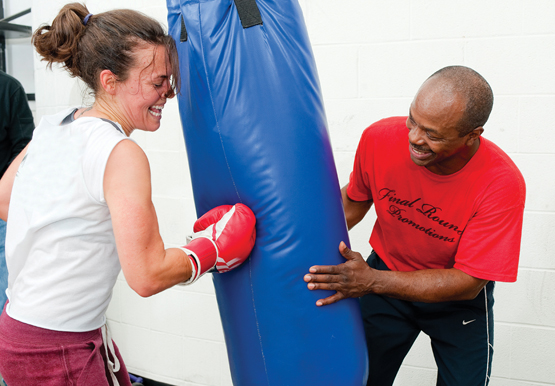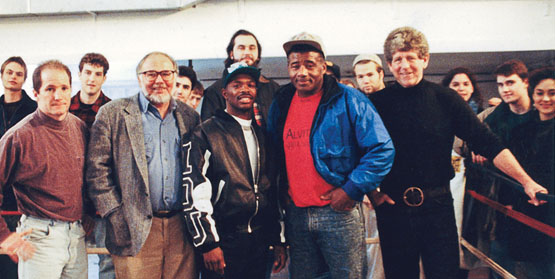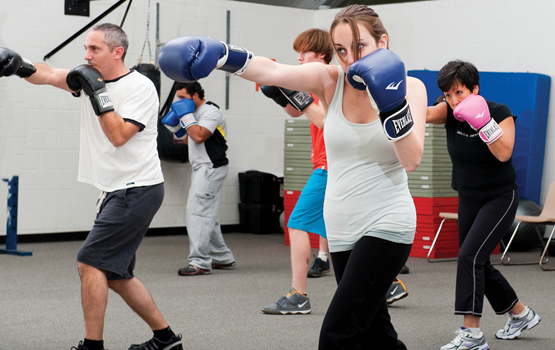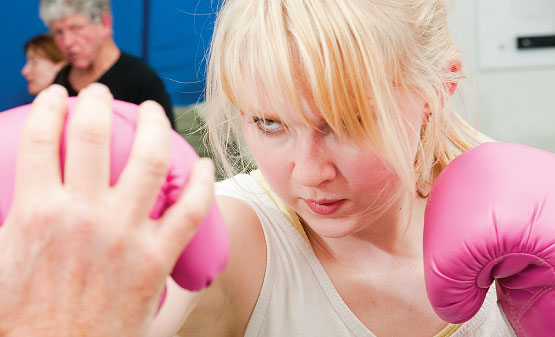Boxing at Vassar
Boxing is a sport one doesn’t normally associate with Vassar, but it’s one of the most popular fitness programs on campus.

Nearly two decades ago, in 1994, the distinguished medieval historian and faculty member Benjamin G. Kohl and I teamed up to create a multidisciplinary course for the American Culture Program titled “Reading the Fights: Boxing and American Values,” arguably the first of its kind in higher education and certainly the only Vassar course to be featured in both The Ring magazine and the New York Times. Today, what began as an intellectual exploration has grown to become a popular fitness program that challenges even the toughest athletes. The Boxing Room in Walker Field House is fully equipped with gloves, mirrors, jump ropes, speed bags, and heavy bags, but what makes Vassar’s program special is the quality of instruction—former boxer and trainer Brian Burke and former two-time world champion Tracy Patterson are master teachers.
The course Ben and I taught used boxing as a lens to view American values and problems—like racism, sexism, corruption, and violence—as well as American notions of masculinity. We read poems by our current poet laureate, Philip Levine, fiction by Ralph Ellison, and essays by Joyce Carol Oates, writers whose fascination with boxing joined that of earlier enthusiasts like Dickens, Byron, Thackeray, Hemingway, and Mailer. We examined cinematic and artistic representations of boxing as well as the social history of the sport. We saw how boxing mirrored the history of immigration and the 20th-century struggles of minorities: Initially Irish boxers rose to prominence from the bottom rungs of the social ladder, followed by Jewish and Italian champions, African American fighters, and now Latino boxers, who have come to dominate the sport in a way they hadn’t previously. Boxing was the first professional sport to break the color barrier, and boxer Joe Louis was the first African American to become a national hero.
The historical and literary perspectives Ben and I brought into the classroom merged with an interest we shared since the time we were both boys listening to the fights on the radio and later watching them on TV with our dads. To enrich the course, we invited guests to campus, like former super-lightweight champion Billy Costello and the writer Leonard Gardner, author of the splendid novel and screenplay Fat City, a classic of boxing literature and film.
In addition to the classroom work, we called on then chair of Vassar’s physical education department, Roman Czula, and World Police & Fire Games boxing champion Brian Burke to arrange optional gym classes in boxing, subsidized by the American Culture Program. Brian, whose sister was a Vassar grad, and Tony Stronconi, another former fighter and active trainer, became Vassar’s first teachers of “non-contact boxing,” a misnomer because students had plenty of contact as they pounded away at speed bags, heavy bags, and the focus mitts that instructors wear to block punches. The only thing students didn’t do was spar with each other. (Tony’s son, Anthony Stronconi ’02, an amateur boxer and upstate Golden Gloves champion, later taught the course while attending Vassar and for a couple of years after graduating, when he went on to win an Empire State championship.)

Floyd Patterson and Vassar
Both Brian and Tony had trained as fighters with the two-time heavyweight champion Floyd Patterson at his Huguenot Boys Club in New Paltz, where the former champ had opened a boxing club partly to address the high rate of drug problems in the area. Patterson, praised by Muhammad Ali as having the fastest hands of anyone he’d fought, offered a gentle mantra to young, troubled kids: “You want to get high? I’ll show you how to get high. Put on these gloves.” Patterson also trained local students, amateurs, and pros, including his adopted son, Tracy, who came to Vassar during the initial year of the course to give demonstrations with Brian.
Students in the first boxing class made the trek across the Hudson River to watch Tracy train for a defense of his world super-bantamweight championship. Amid polite, soft-spoken trainers and boxers, students watched Floyd massage his son’s knuckles and fingers before wrapping them. They glimpsed aspects of boxing as a culture in itself—a culture that encompasses explosive, controlled violence and surprising moments of intense tenderness. When Brian, who was Tracy’s co-trainer, called out, “Quiet, please, we’re going to box now,” one student later told me, “I thought I was in church.”
Sonia Slutsky ’94, a member of that first boxing class, recalls that she’d come to the course angrily dismissing everything about the sport but grew to appreciate and respect it, which appalled her mother, who told me at graduation, “What next? A course on the NRA?”
Sonia, who grew up as the smallest kid in her class, hadn’t participated in team sports but liked how the mental intensity and physical exhaustion of boxing allowed her to withdraw from the outside world and focus on the present. The most memorable moment in the academic course for her was when she met Floyd Patterson. “His face was sweet and gentle,” Sonia recalled, “like a lovable older uncle or grandfather.” While Patterson told the class a story about a fight, he assumed a boxer’s pose and put up his hands to protect his face. “In that instant,” Sonia said, “this sweet and gentle man transformed into a fighter. Something came over his body and his demeanor, and I remember feeling goose bumps. He was now the man who knocked out all those heavyweights.”
Shanlon Wu ’80 visited our class to tell students about his training with Floyd Patterson long before there was a Vassar boxing room. He recalled that he was trying to teach himself to use the lone speed bag, then hanging in Kenyon gym, when a friend suggested he might train with Patterson across the river along with another Vassar student.
When Shanlon met the champ in his New Paltz front yard, Floyd wore a baseball cap, leaned on a rake, and looked like a farmer or gardener. “I was surprised,” Shanlon recalled, “at the powerful field of peacefulness about him.” Only Patterson’s hands gave away his true profession. “They were huge, flattened, and perpetually swollen at the knuckles.”
Patterson explained to Shanlon the cost of his training: As long as he trained he paid nothing; only if he stopped did he owe monthly dues. “It was that peacefulness about Floyd that I sought. He’d been to great battles and returned. No question remained of his courage. I wanted to feel the same about myself.” When the bell rang between rounds during training, Floyd would rest his big hand for a moment on Shanlon’s shoulder. “It was a comforting, steadying connection, and I sometimes imagined he tried to flow into his fighters some of his greatness in that brief touch.”

The Art of Boxing
“When Floyd Patterson shuffled into a photography exhibit at Vassar College,” the New York Times reported in 1996, “with all the stoop-shouldered grace of a former heavyweight champion, the art gallery there fell into an adoring silence.” (The Times went on to inform its readers, “Vassar is a tony liberal-arts college in Poughkeepsie, NY.”) The occasion was an art exhibition Ben and I curated to complement the course when we taught it for a second time. Fifty-four boxing prints and photos hung in the Frances Lehman Loeb Art Center, titled “American Fighters: A Century of Boxing in Art,” ranging from Thomas Pye’s sepia-toned view of an 1889 bare-knuckle fight to Richard Avedon’s contemporary portrait of a pensive champion, Oscar De La Hoya, a photograph that remains in the college’s permanent collection, thanks, in part, to a gift from Ben and Judy Kohl.
We celebrated the closing of the exhibition with “The Art of Boxing: A Vassar College Symposium,” in Skinner Hall, where Floyd and the former light-heavyweight champion José Torres, along with a panel of three art photographers—Larry Fink, Toby Old, and Arlene Schulman—joined novelist and author of On Boxing Joyce Carol Oates (noted for her startling claim that “life is a metaphor for boxing”) and Vassar students from the class onstage to address a packed auditorium for two hours. Possibly helping to fill the hall were campus rumors of a potential visitor, the pop star Madonna, an avid collector of boxing photos who had loaned us some prints for the exhibition. (She didn’t come.)
Twenty-two-year-old English major Debbie Brand ’96 did come and remembers how she “actually got to challenge Joyce Carol Oates on the notions of masculinity in front of a live audience.” the New York Times reported Debbie saying that the panelists hadn’t fully addressed some of her concerns about violence and sexism in the sport. Brain-damaged boxers, half-naked ring girls, corrupt managers, and exploited minorities had sparked some of our class discussions. “Boxing is a moral and intellectual challenge,” Debbie told the Times.
Debbie hadn’t come to Vassar as a fight fan, but her aggressive training in the gym caused a classmate to nickname her “Killer.” “Boxing had so absorbed me,” she recently said, “that I even continued to train after I suffered an ACL tear in my final college basketball game.” When she injured her knee again during a boxing workout, “the trainers surrounded me, transforming from hard-nosed drill sergeants to compassionate friends. Their gentleness only pushed me harder and deepened my passion.”
Learning about boxing in both the classroom and gym was a transformative experience for Debbie. “I left the class with a new outlook on the world,” she said. “Learning about the art of pugilism both in theory and in practice helped to make boxing part of my being. One without the other would never have accomplished that. How ironic that something so ‘barbaric’ could civilize me so directly.”
In 1996, at the end of spring semester, the academic course “Reading the Fights” properly self-destructed in accordance with an American Culture Program rule limiting all such “special studies” courses to two offerings, a mandate instituted to ensure fresh, innovative topics for special study.

Mitts and Gloves
Boxing as an exercise has now flourished on campus for 18 consecutive years, with ex-champ Tracy Patterson becoming a full-time co-teacher after his retirement from professional boxing in 2001. “Non-Contact Boxing with Brian and Tracy” is taught in four classes as part of 130 hours of non-credit Life Fitness classes offered each week and supervised by program director Roman Czula. “For strength and aerobics, boxing is one of the best workouts,” Czula says. “Anyone who’s taken this class—even someone with a disdain for boxing—has a totally different perspective afterward. And to see the speed, power, and endurance of the instructors is stunning.”
Joe Langdon ’05 saw Tracy’s speed and power when the ex-champ threw a combo at the heavy bag. “He’s not a big man,” Joe said, “but the sound it produced was amazing, and I remember being shocked at the length of his arms and how easily they made the big bag swing, hard enough to ease the tension in the chain. It was frightening and graceful, and oddly tranquilizing. Rather than a violent enterprise, boxing makes one feel more peaceful and centered.”
Other students stress the intensity and addictive character of the workouts. Liz Zack ’96 recalled the sheer physical exhaustion that she and her best friend experienced after their first boxing class. “I spent a lot of time in the gym back then,” she said, “so I remember thinking that the physical aspects of the class would be pretty easy for me.” She recalled how the instructor told everyone to lie on their backs and start doing sit-ups. “He blew the whistle around his neck, gym-teacher style, and then kind of like walked away.” The crunches left her abdominal muscles unable to respond to her brain’s direction. “And these,” she said, “are ridiculously fit, 19-year-old abdominals we’re talking about.” The next day, she learned that her friend “had called security because she couldn’t walk or crawl or stand and had to be taken to the infirmary to get emergency muscle relaxers. Amazingly we convinced each other to try it again the next week!”
“Boxing is a disease,” Brian repeatedly tells the students. “Once it gets you, you can’t shake it.”
When I asked Tracy if boxing without hitting and getting hit is like a song without music, he replied, “That’s not what we’re about here. The point is to get down the technique and to train like a boxer to get into shape.”
Students I talked to echoed Tracy’s point: There’s no better method of physical conditioning than to go through a boxer’s training; in addition, the quality of the instructors and the emphasis on technique distinguish the Vassar class from other aerobic boxing workouts.
Brandon Thomas ’03, who played varsity basketball at Vassar, said that the one-hour boxing class left him feeling as though he’d been in the gym for hours. “Two- or three-hour practices on the basketball court rarely had left me that exhausted.”
Brandon, like other beginners, first learned the proper boxer’s stance and how to throw five punches—a jab, right cross, left hook, right and left body uppercuts—all numbered in sequence, from one to five. He followed a circuit of shadow boxing, skipping rope, hitting the speed bag, punching the heavy bag, and throwing punches at focus mitts while the instructor barked out combination numbers in rapid succession for three-minute stints—“one, two...one, two, five...one, two, five, four, three...” In the advanced class, he also threw uppercuts to the chin, numbered six and seven.
To show students how to punch with technical accuracy—a discipline that goes against the instinctual habits of street fighting—the instructors demonstrate with mitts and gloves. “To watch Brian and Tracy dance around the room was to watch a deliberateness that was inspiring,” Brandon said, “and when Brian connected with Tracy’s mitts, the sound reverberated beyond the workout room and into the gym. As someone who had valued footwork on the basketball court, I remember thinking how graceful he was. The girls, too, were both shocked and in awe of the speed he exemplified, magnified by the power his small frame exhibited with every punch. I wanted to be that quick.”
When a student in class said, “I never knew boxing was so hard,” Tracy responded, “I hope you can see that it isn’t just two guys trying to beat each other up. It’s a science. Not too many people can do it.”
Like chess, it’s also an intellectual game. For every move, there’s a countermove. And as boxers repeatedly say, the real battle, both physical and mental, is not with another but with yourself.
Vassar women, Tracy noted, are actually easier to teach than the men and show quicker improvement. “They’re looser,” he said, “more relaxed. The guys come in tight and tense, wanting to kill.”
Carrying on the Tradition
Some Vassar alums maintain a connection to boxing after leaving campus. Joe Langdon, now an MFA student, continues to work out and has written stories and published a magazine article about a professional cruiserweight in Las Vegas.
Sonia Slutsky still has qualms about boxing’s risk of injury and glorification of violence; her son, she says, won’t box—or play football. “But as a documentary filmmaker and TV producer,” she adds, “I’ve done a few stories and filmed in several boxing gyms. I have seen firsthand how boxing has changed people’s lives for the better.”
After graduation, Aleksa Mendive ’98 bought her own hand wraps, gloves, and heavy bag, even though, she said, “I remember the first class being such an intense workout that I went back to my dorm and had my first migraine headache. I loved the class, though, especially the whole process of wrapping your hands, putting on gloves, and learning the moves that would make me feel like a real boxer.” She has often thought about taking another class, but says, “Most of the gym classes that offer kickboxing or boxing don’t seem as authentic as that Vassar experience was.”
Katie Aspell ’10 has actually returned to campus to continue the boxing course because, she says, “It makes me feel tough.”
Whatever the attraction for this demanding exercise, non-contact boxing at Vassar continues to draw students, alums, staff, administrators, and faculty, as well as participants beyond the campus. In line with Vassar’s increased efforts in the last few years to breech the wall between town and gown, program director Czula opened up all of the Life Fitness Classes to the greater Poughkeepsie community. “About 20 percent of our classes are non-Vassar,” he said, although the percentage is higher in some of the boxing classes, ranging from several adults to 14-year-old Cameron Beyer, who started the course when he was 10.
Current senior Kelly Shortridge ’12 began boxing classes when she was a sophomore—“quite frankly,” she said, “because I wanted to learn how to fight properly.” She claimed she never, ever skipped class—“I even went in the depths of flu once”—because of the satisfaction in knowing she’d tried her hardest. In a team sport, she said, blame for a loss is spread on everyone. “In boxing, if you give up, it’s all on you.”
Because Kelly also plays the violin in the Vassar College Orchestra, she bought padded wraps and her own gloves to protect her hands. “Also my gloves are pink,” she said, “so it’s a way to show my girly side even while slamming away at the heavy bag. Boxing is one of the top things I’ll miss when I leave Vassar.”
Frank Bergon is a novelist and professor emeritus of English. His new novel is Jesse’s Ghost.
